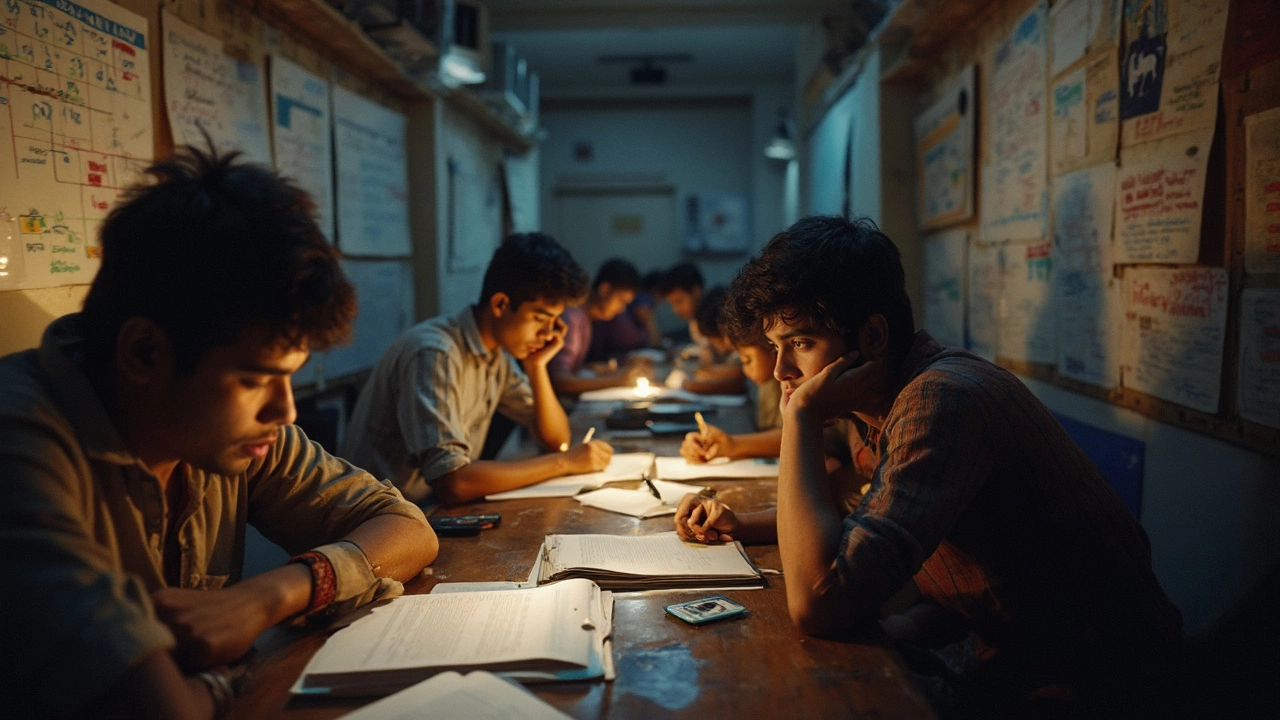Everyone says getting into IIT Bombay is insanely hard—honestly, they're not wrong. If you think the JEE is just a tough test, you haven't seen the backstory. Out of nearly 1.5 million students who show up for the JEE Main every year, only about 16,000 make it to any IIT. Now, out of those, just a tiny slice get a seat in IIT Bombay. Last year, the top 80 ranks for Computer Science were all snatched up by kids who had almost perfect scores. So yeah, the odds aren’t just low—they’re microscopic.
But it's not just about the numbers. It’s the level of prep and the pressure that crushes people. The timeline is brutal: two full years of study, piles of books, mock tests every other weekend, and a stream of “helpful advice” from relatives. People back out, get burnt out, or just can't keep up. But it's not impossible—with the right attitude and plan, students from all kinds of backgrounds crack it every year.
- The Brutal Numbers & Chances
- What Makes IIT Bombay So Special
- Preparation: What Top Performers Actually Do
- Smart Strategies for Getting Ahead
The Brutal Numbers & Chances
If you want to grab a seat at IIT Bombay, you’re fighting against the odds—big time. Each year, over 1.5 million students register for the JEE Main. Only about 10% (150,000) are invited to take the JEE Advanced, which is the second round. When it comes to getting into IIT Bombay, the cut is even sharper: just a few hundred out of those thousands actually make it in, especially for the most popular branches like Computer Science.
The competition isn’t just about clearing the cutoffs. You’re up against the best students from across the country. Even if you solve problems quickly, the paper is designed to trip you up—questions twist common concepts and your speed and accuracy both matter. To really see how hard it is, check out the numbers from the most recent admission cycle:
| Stage | Number of Students | % Progressing to Next Stage |
|---|---|---|
| JEE Main Applicants | 1,500,000 | 100% |
| Qualified for JEE Advanced | 150,000 | 10% |
| IIT Seats (all branches, all IITs) | 16,000 | 1% |
| IIT Bombay B.Tech Seats | 1,360 | 0.09% |
| IIT Bombay CSE Seats | 124 | 0.008% |
Look at that last row for Computer Science—it’s brutal. Fewer than 1 in 12,000 JEE Main takers land a CSE seat at IIT Bombay. Even for other branches, you need a rank somewhere in the top 1500, which means you’re competing with not just smart, but super-dedicated kids from all types of backgrounds—metros, small towns, even remote villages.
Just to put it in perspective: getting into the Ivy League in the US often means a 4%-7% acceptance rate. For IIT Bombay CSE, you’re chasing something much tighter. Knowing this, most serious aspirants start prepping in class 11, or even earlier. You’ve got to be consistent, not just smart. There’s simply no room for lazy days if you’re shooting for this target.
What Makes IIT Bombay So Special
So why do students go all out for IIT Bombay, even though the fight is this cutthroat? It’s not just about bragging rights or the campus. Here’s what really sets it apart.
First, let’s talk about placements. Companies line up every year, and we’re not talking only Indian firms. Google, Microsoft, Goldman Sachs—you name it, they recruit from here. Salaries stretch into the crores for top roles, and even the average paycheck is rock-solid. Check this out:
| Placement Year | Average Package (INR Lakhs) | Highest Package (INR Lakhs) |
|---|---|---|
| 2023 | 21.8 | 3.67 Crore (overseas) |
| 2022 | 18.1 | 2.1 Crore (overseas) |
That’s not just hype. The numbers back it up.
The vibe on campus is another reason. Everyone here is driven, and it rubs off on you. You learn to work with some of the smartest folks your age. Plus, there’s insane freedom: from research labs to music clubs, it’s easy to find your crowd. Big festivals like Mood Indigo and Techfest bring in celebs and tech leaders from all over the world.
Also, if you dream of studying abroad or working for a global company, IIT Bombay is your launchpad. Alumni go everywhere from MIT to Stanford, or head straight into companies like Apple and Tesla. The IIT Bombay tag actually opens doors beyond India.
- Best location—right in Powai, Mumbai, so internships and networking come easy.
- Huge, modern campus and hostels that don’t feel like boxes.
- Faculty who actually care—loads of them have studied or taught overseas.
- Startup-friendly culture with access to funding and mentors through the SINE incubator.
At the end of the day, the competition is so fierce because students see real value. It’s not just about a degree, but about what comes after—career, connections, and lifelong confidence.

Preparation: What Top Performers Actually Do
If you think toppers are “born smart,” you’re missing the point. The kids who make it to IIT Bombay all have different backgrounds, but their prep habits are surprisingly similar—and you don’t need genius-level IQ to copy them. It’s all about doing the right things, every single day, for almost two years straight.
The most obvious thing? Consistency. Most top scorers clock in 6–8 hours of focused prep outside school hours, but it isn’t just about total study time—it’s about brutal honesty. Here’s what keeps them ahead:
- Don’t just read—practice: Daily problem-solving is non-negotiable. It’s common to solve over 10,000 problems before the JEE.
- Stick to the right books: Nearly every topper swears by NCERT for theory, then moves on to books like HC Verma for Physics, and MS Chouhan for Organic Chemistry. They don’t get distracted by too many sources.
- Test, fail, learn, repeat: Mock tests (at least one per week from class 11 onwards) aren’t just for scoring—they’re to find weak spots fast. You don’t want surprises in the actual exam.
- Revise, revise, revise: There’s A LOT to forget if you don’t revise. Top students set aside a few hours every week just to go back over old notes and mistakes.
- Ask for help: Toppers don’t get stuck alone—they ask teachers, use online forums, and even peers, but never let doubts pile up.
And just to give an idea of real effort, here’s a snapshot of how much time some current IITians spent per subject, every week, in the last six months before their exams:
| Subject | Weekly Study Hours (Average) |
|---|---|
| Physics | 12 |
| Chemistry | 10 |
| Maths | 14 |
Some even cranked it up to 40 hours a week if they had gaps to fill or if they were close to exam day. And yes, almost everyone took short breaks and made sure to get enough sleep—no one can memorize formulas while half-asleep.
So forget magic tricks. It’s all about grinding every day, owning up to weak spots, and staying on top of revision. The guys who clear the cut-off for IIT Bombay aren’t superhuman—they’re just relentless and brutally honest with themselves.
Smart Strategies for Getting Ahead
If you want a real shot at IIT Bombay, you need to play it smart. It’s not enough to just study hard; you need to use your time, tools, and mindset in ways that push you past the average JEE aspirant. Here’s what actually helps people stand out:
- Don’t chase every book out there. The best rankers stick to a few core resources. NCERT for basics, then standard books: Physics (H.C. Verma, Irodov for some problems), Chemistry (O.P. Tandon, Morrison & Boyd for organic), Math (Cengage or Arihant series). Pick your books, finish them properly, and revise. Jumping to new material every week just causes confusion.
- Mock tests aren’t optional. You have to simulate the real exam again and again. Take at least two full-length mocks every month in 11th, then one every week by the time 12th starts getting serious. Practice on computers, not paper, since JEE is online. After each test, spend time reviewing your mistakes—that’s where the actual gain is.
- Don’t ignore weak areas. Look at last year’s toppers—they worked on the stuff they hated, not just their best subjects. The examiner sets questions to catch people hiding from their weak spots.
- Group study—use it for doubts, not distraction. If you have a friend who’s serious, schedule half-hour doubt-sessions every few days (on video call or in person). Talk through sticky problems, but don’t let it turn into banter or social media scrolling.
- Smart notes beat pretty notes. Instead of writing everything, keep a set of cheat sheets—mistake lists, formulas, quick tricks. Before every mock or actual exam, revise just these. This isn’t just a time-saver; it trains you to recall under pressure.
One more underrated move—take real breaks. Set alarms if you have to; 15-minute walks or quick exercise wakes your brain up. Students who grind non-stop usually crash before the finish line. Last thing: if something doesn’t make sense, find a way—YouTube, seniors, online forums. No ego, just solutions.




